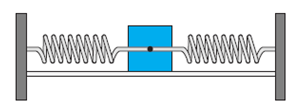
Concept explainers
In Exercises 9 and 10, we consider a mass sliding on a frictionless table between two walls that are 1 unit apart and connected to both walls with springs, as shown below. 
Let k1, and k2be the spring constants of the left and right spring, respectively, let m be the mass, and let b be the damping coefficient of the medium the spring is sliding through. Suppose L1and L2are the rest lengths of the left and right springs, respectively.
10. (a) Convert the second-order equation of Exercise 9 into a first-order system.
(b) Find the equilibrium point of this system.
(c) Using your result from part (b), pick a new
(d) How does this new system compare o the system for a damped harmonic oscillator?
Want to see the full answer?
Check out a sample textbook solution
Chapter 2 Solutions
Differential Equations
- It may surprise you to learn that the collision of baseball and bat lasts only about a thou- sandth of a second. Here we calculate the average force on the bat during this collision by first computing the change in the ball's momentum. The momentum p of an object is the product of its mass m and its velocity v, that is, p = mv. Suppose an object, moving along a straight line, is acted on by a force F = F(t) that is a continuous function of time. (a) Show that the change in momentum over a time interval [to, t1] is equal to the integral of F from to to t1; that is, show that p(t) – p(to) = |" F(t) dt This integral is called the impulse of the force over the time interval. (b) A pitcher throws a 90-mi/h fastball to a batter, who hits a line drive directly back to the pitcher. The ball is in contact with the bat for 0.001 s and leaves the bat with velocity 110 mi/h. A baseball weighs 5 oz and, in US Customary units, its mass is measured in slugs: m = w/g, where g = 32 ft/s². (i) Find the…arrow_forwardCalculate the force and moment reactions at the bolted base O of the overhead traffice-signal assembly. Each traffic signal has a mass of 30 kg. while the masses of members OC and AC are 78 kg and 65 kg, respectively. Positive answers are to the right, up, and counterclockwise. 30 kg Answers: O₂= Mo 6.0 m 30 kg 1.0 KN KN kN-m 5 m 65 kg 78 kg 7.4 marrow_forwardSolve both parts properlyarrow_forward
- An object of mass m moves at a constant speed v in a circular path of radius r. The force required to produce the centripetal component of acceleration is called the centripetal force and is given by F = mv2/r. Newton's Law of Universal Gravitation is given by F = GMm/d2, where d is the distance between the centers of the two bodies of masses M and m, and G is a gravitational constant. The speed required for circular motion is v = √ GM/r. Use the result above to find the speed necessary for the given circular orbit around Earth. Let GM = 9.56 x 104 cubic miles per second per second, and assume the radius of Earth is 4000 miles. (Round your answer to two decimal places.) The orbit of a communications satellite R miles above the surface of Earth that is in geosynchronous orbit. [The satellite completes one orbit per side real day (approximately 23 hours, 56 minutes), and therefore appears to remain stationary above a point on Earth.] X mi/sarrow_forwardA spring has a natural length of 10 feet, and when an 64lb weight is attached, the spring measures 13.2 feet. The weight is initially displaced 4 feet above equilibrium and given a downward velocity of 3 ft/sec. Find its displacement for t>0 if the medium resists the motion with a force of two Ibs for each ft/sec of velocity.arrow_forwardThe automobile has a mass of 2 Mg and the center of mass at G. Determine the towing Q3 |30 0.6 m force F required to move the car if the back 0.3 m brakes are locked and the front wheels are -1m+1.50 m 0.75 m free to roll. Take us = 0.3.arrow_forward
- The force P = 15 lb is applied to the cable and the cords slip on the smooth surfaces of the non- rotating pulleys. Determine the magnitude and direction of the acceleration of the 36-lb cylinder if (a) the pulleys are massless, (b) the pulleys are 4 lb each. (a = 21.5 ft/sec², a = = 6.9 ft/sec²) P Warrow_forwardRepeat Exercise 27 for the forces KX = (2, – 3) and KY = (- 2, 3).arrow_forward
 Trigonometry (MindTap Course List)TrigonometryISBN:9781337278461Author:Ron LarsonPublisher:Cengage Learning
Trigonometry (MindTap Course List)TrigonometryISBN:9781337278461Author:Ron LarsonPublisher:Cengage Learning
